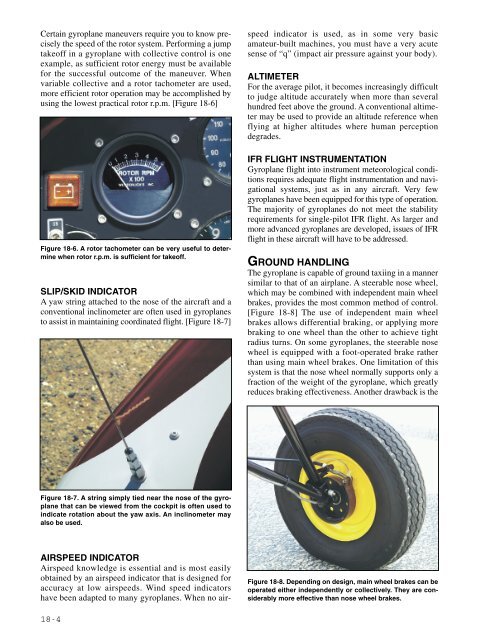Rotorcraft Flying Handbook, FAA-H-8083-21
Rotorcraft Flying Handbook, FAA-H-8083-21
Rotorcraft Flying Handbook, FAA-H-8083-21
You also want an ePaper? Increase the reach of your titles
YUMPU automatically turns print PDFs into web optimized ePapers that Google loves.
Certain gyroplane maneuvers require you to know precisely<br />
the speed of the rotor system. Performing a jump<br />
takeoff in a gyroplane with collective control is one<br />
example, as sufficient rotor energy must be available<br />
for the successful outcome of the maneuver. When<br />
variable collective and a rotor tachometer are used,<br />
more efficient rotor operation may be accomplished by<br />
using the lowest practical rotor r.p.m. [Figure 18-6]<br />
Figure 18-6. A rotor tachometer can be very useful to determine<br />
when rotor r.p.m. is sufficient for takeoff.<br />
SLIP/SKID INDICATOR<br />
A yaw string attached to the nose of the aircraft and a<br />
conventional inclinometer are often used in gyroplanes<br />
to assist in maintaining coordinated flight. [Figure 18-7]<br />
AIRSPEED INDICATOR<br />
Airspeed knowledge is essential and is most easily<br />
obtained by an airspeed indicator that is designed for<br />
accuracy at low airspeeds. Wind speed indicators<br />
have been adapted to many gyroplanes. When no airspeed<br />
indicator is used, as in some very basic<br />
amateur-built machines, you must have a very acute<br />
sense of “q” (impact air pressure against your body).<br />
ALTIMETER<br />
For the average pilot, it becomes increasingly difficult<br />
to judge altitude accurately when more than several<br />
hundred feet above the ground. A conventional altimeter<br />
may be used to provide an altitude reference when<br />
flying at higher altitudes where human perception<br />
degrades.<br />
IFR FLIGHT INSTRUMENTATION<br />
Gyroplane flight into instrument meteorological conditions<br />
requires adequate flight instrumentation and navigational<br />
systems, just as in any aircraft. Very few<br />
gyroplanes have been equipped for this type of operation.<br />
The majority of gyroplanes do not meet the stability<br />
requirements for single-pilot IFR flight. As larger and<br />
more advanced gyroplanes are developed, issues of IFR<br />
flight in these aircraft will have to be addressed.<br />
GROUND HANDLING<br />
The gyroplane is capable of ground taxiing in a manner<br />
similar to that of an airplane. A steerable nose wheel,<br />
which may be combined with independent main wheel<br />
brakes, provides the most common method of control.<br />
[Figure 18-8] The use of independent main wheel<br />
brakes allows differential braking, or applying more<br />
braking to one wheel than the other to achieve tight<br />
radius turns. On some gyroplanes, the steerable nose<br />
wheel is equipped with a foot-operated brake rather<br />
than using main wheel brakes. One limitation of this<br />
system is that the nose wheel normally supports only a<br />
fraction of the weight of the gyroplane, which greatly<br />
reduces braking effectiveness. Another drawback is the<br />
Figure 18-7. A string simply tied near the nose of the gyroplane<br />
that can be viewed from the cockpit is often used to<br />
indicate rotation about the yaw axis. An inclinometer may<br />
also be used.<br />
Figure 18-8. Depending on design, main wheel brakes can be<br />
operated either independently or collectively. They are considerably<br />
more effective than nose wheel brakes.<br />
18-4

















